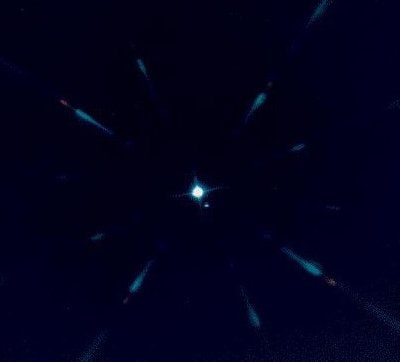The white dwarf orbiting Sirius began its life as a blue star with 5 times the Sun’s mass, say astronomers in Arizona and New Mexico. If this blue star still shone today, Sirius would be so bright it would cast shadows on Earth.
Now, James Liebert, David Arnett, Jay Holberg, and Kurtis Williams of the University of Arizona and Patrick Young of Los Alamos National Laboratory have studied Sirius’ evolution. They first had to know the stars’ masses, because the more massive a star, the faster it evolves. The two stars orbit each other every 50 years. This orbital motion reveals that Sirius A, the brighter star, has 2.02 ± 0.03 solar masses and Sirius B, the white dwarf, has 1.00 ± 0.02 solar masses.
Liebert and his colleagues then determined the age of Sirius A. As a main-sequence star ages, its luminosity and diameter change. Recent interferometric work found Sirius A’s diameter to be 71-percent greater than the Sun’s. By modeling the evolution of a star with Sirius A’s mass, the astronomers find the star achieves its current luminosity and diameter 225 to 250 million years after birth. This age means Sirius has completed just one orbit around the galaxy. In contrast, the Sun is 4.6 billion years old — 20 times older.
Next, Liebert’s team examined Sirius B. It was once a main-sequence star, like Sirius A. Then it swelled into a red giant and shrank into a white dwarf. White dwarfs cool and fade as they age. From Sirius B’s mass and temperature (25,000 kelvins), the astronomers estimate the star became a white dwarf around 124 million years ago. Thus, the star shone as a main-sequence star and then a red giant for 101 to 126 million years — the expected lifetime of a star born with about 5 solar masses.
A main-sequence star with this mass would have emitted a few times more light than Regulus in Leo, which a 2005 study found has 3.4 solar masses. If Sirius B shone so brightly today, it would look brighter than Venus — bright enough to cast shadows. When Sirius B became a red giant, it must have lost 80 percent of its mass, because today it has the same mass as the Sun.
The new work casts further doubt on a long-held belief that Sirius moves through space with the five central stars of the Big Dipper. In 1909, Danish astronomer Ejnar Hertzsprung said Sirius probably belonged to the so-called Ursa Major moving group, whose core is 80 light-years away. In 2003, however, Jeremy King of Clemson University and his colleagues questioned whether Sirius was truly a member of the group. They also put the group’s age at 500 million years. This is twice the age Liebert and his colleagues find for Sirius, suggesting the two have nothing to do with each other.
The astronomers will publish their work in a future issue of Astrophysical Journal Letters.










